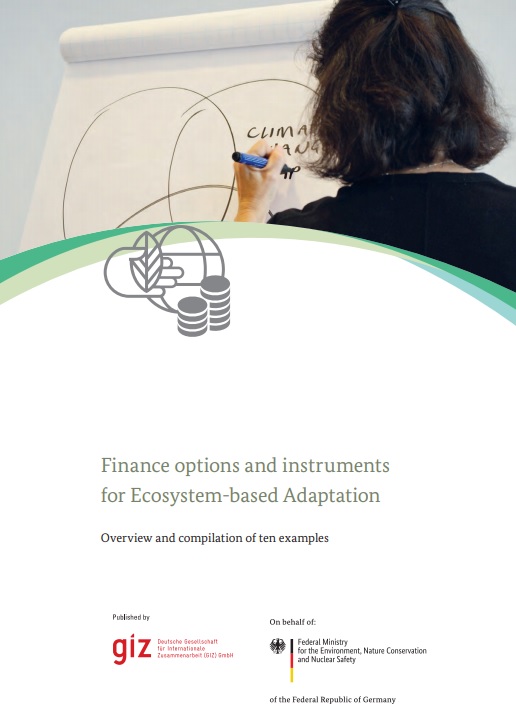Overview
« Finance Options and Instruments for Ecosystem-based Adaptation », a new report by the German Agency for International Cooperation (GIZ), provides an overview of available financing sources for EbA measures from multilateral funds and development banks to bilateral technical and financial cooperation, debt-for-nature swaps, domestic budgets, nonprofit organizations and market debt. It also spotlights EbA-relevant financial instruments, including green bonds and debt financing, payment for ecosystem services, risk insurance and more. Ten project examples illustrate how funding sources have been harnessed to implement and maintain various EbA measures.
The publication presents:
i. a categorization of relevant financing sources for EbA,
ii. a list of financing instruments, and
iii. insights into ten potentially replicable examples to finance EbA measures.
The report provides a comprehensive outlook on available financing sources and stipulates examples for project developers and practitioners who might be keen to learn from different finance approaches. It showcases practical finance approaches relevant for the integration of (ecosystem-based) adaptation in the context of national and subnational climate policies such as Nationally Determined Contributions (NDC) and National Adaptation Plans (NAP)
Contents
Introduction
- The importance of finance support for EbA
- Relevant financing sources for EbA measures
- Overview of financing instruments relevant for EbA financing
- Case study analysis
Examples of EbA finance options and instruments
- Example 1Engaging the private sector for EbA finance in Cartagena, Colombia
- Example 2 The High Atlas Foundation Tree Nursery, Morocco
- Example 3 Restoring degraded forests and agricultural landscapes under the Green Climate Fund, The Gambia
- Example 4 People’s Survival Fund, the Philippines
- Example 5 Impact Mitigation Regulation, Germany
- Example 6 Relevance of insurance systems for financing EbA
- Example 7 Increasing the resilience of vulnerable populations through microfinance, Colombia & Peru
- Example 8 eco.business Fund, Latin America
- Example 9 Carbon insetting
- Example 10 Debt-for-nature swaps
Keys messages
The report provides a comprehensive outlook on available financing sources and stipulates ten examples for project developers and practitioners who might be keen to learn from different finance approaches to implement and maintain EbA measures. It offers the opportunity to showcase possibilities for EbA to be considered within National Adaptation Plan (NAP) processes and Nationally Determined Contribution (NDC) strategies.
Financing sources for EbA measures stem from both domestic and international funds, which originate from public and private sources. International funds from public sources include multilateral funds (for example the Green Climate Fund and the Adaptation Fund), multilateral development banks, bilateral technical and financial cooperation as well as debt-for-nature swaps. Domestic public sources, such as national funds and budgets, are complemented by private sources, which encompass certification schemes, nonprofit organizations and market debt.
Several instruments are relevant for EbA financing. In addition to grants, green bonds and debt financing, payment for ecosystem services, risk insurance as well as taxes, fees and charges are possible. Access to green markets, equity financing and guarantees constitute further instruments. There is no one-size-fits-all solution for financing EbA, as measures are highly context specific regarding for example climate risks and ecosystems, geographical scale and level of implementation.
Different stakeholders face different costs that require various financing mechanisms. Often, a combination of finance instruments and sources has to be applied to guarantee the coverage of both investment costs (the costs associated with the development of infrastructure, capacity and technology) and operating costs (the ongoing
expenses incurred to support the coordination and facilitation of the EbA measure throughout its lifetime).
The ten examples illustrate how the funding sources have been harnessed for different EbA measures, including flood prevention, desertification, forest degradation, resilience building, and carbon insetting:
- In Cartagena, Colombia, a compensation for sealing green areas and an event fee which contribute to the city’s environmental infrastructure for flood prevention, engage the private sector. By communicating the benefits of EbA measures, an incentive structure was created to leverage private finance sources.
- The High Atlas Foundation Tree Nursery in Morocco blends public funding from governmental institutions for the project’s non-profitable aspects with revenue generation through the sale of carbon credits and certified products. It thereby ensures long-term financial sustainability and independence from future donations.
- Degraded forests and agricultural landscapes were restored under the Green Climate Fund in the Gambia. Rural households within community-managed forest reserves and conservation areas benefitted from the multilateral public fund which was channeled to the Gambian Ministry of Environment through UNEP to
provide a grant for the execution of the project.
- The Philippines People’s Survival Fund provides financial support for resilience building on a local level. The national fund is dedicated to projects which are accredited based on their track record in the community, financial management and participatory practices, and which integrate poverty and disaster risk reduction
with climate change adaptation objectives.
- In Germany, a credit system compensates ecological loss from development projects. The expected degradation of the ecological value of a project site is estimated and the required amount of credits is calculated. Each credit corresponds to a certain ecological value and is sold by landowners and bought by project developers
to offset their environmental impact.
- The positive impact of EbA measures in the set-up of insurance schemes allows for a lower risk for the insurer. Customers and communities who invest in self-protection are offered discounts and hence are incentivized to invest into adaptation measures.
- A microfinance scheme increases the resilience of vulnerable rural populations involved in agriculture in Colombia and Peru. The provision of loans allows farmers to invest in sustainable adaptation practices, decrease their dependency on agriculture and improve their income and resilience towards climate change.
- The eco.business Fund invests in sustainable operations in Latin America by issuing market-rate loans to borrowers that fulfil certain conditions. This public-private partnership thereby promotes business and consumption that contributes to biodiversity conservation and climate change adaptation.
- Carbon Insetting refers to the direct investment of a company within its own value chain. In addition to offsetting carbon emissions, this approach helps companies boost resilience along their value chain and care for the ecosystems that provide their raw materials.
- In debt-for-nature swaps, financial debt owned by a developing country government is cancelled or reduced by a creditor in exchange for financial commitments to conservation. The voluntary transactions are regarded as ‘win-win-win’ solutions, where benefits accrue to debtors, creditors, and ecosystems of debtor countries.
The objective of these examples is to provide a learning experience for actors interested in exploring different ways to access resources and engagement models for EbA financing.



